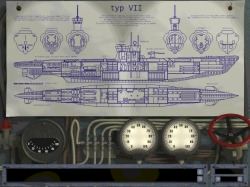By: Len 'Viking1' Hjalmarson
Date: 1999-02-10
For quite some time PC submarining action was dominated by SILENT SERVICE II and RED STORM RISING. Then Dynamix released their excellent ACES OF THE DEEP, where players took to the frigid waters of the North Atlantic as German U-boat captains. Finally, Silent Hunter arrived on patrol.
SILENT HUNTER was first described as ACES OF THE DEEP, only in the Pacific with the US Sub Service, and in high resolution. While that is more or less true, SILENT HUNTER is also a class in itself.
In SILENT HUNTER the player commands an American diesel submarine in WWII. Starting with the infamous attack on Pearl Harbor, hunting season for Japanese warships and merchants opens in the South Pacific. The general idea of the simulation is to sink as much tonnage as possible without ending up on the Still on Patrol list at the end of the war.
The historical faithfulness of AOD is renowned, and SILENT HUNTER hit the same mark for accuracy, employing the services of William "Bud" Gruner, who was the technical advisor for the game.
The Simulations Group at SSI/Mindscape is now at work on several projects for the new "DCS" (Digital Combat Series) line of products, including Harpoon IV and Destroyer Commander. Bill Becker, president of Aeon Electronic Entertainment and SSI Simulations Producer, Rick Martinez, form the nucleus of the Silent Hunter II collaboration.
Executive Producer Carl Norman, (producer of the original Silent Hunter), is now heading up the SSI/Mindscape Simulations Group. Recently we had an opportunity to speak with Rick and Bill about where this new simulation will take us.
CSIM: Lets start with some history. Silent Hunter was a fantastic entry into the genre, keeping my attention in a way that AOD never did. Tell us a bit about the conception of Silent Hunter and what you were attempting to accomplish.
A: The subject of the American submarine force in the pacific had been neglected for quite some time. In fact, Silent Service II (1990) was the last significant game on the subject. We had talked for quite some time with SSI about doing the next generation of WWII sub sim and in early '94 the timing seemed right. From the start our goal was to create the most realistic sub simulation to date using the latest technology and the best graphics in the business.

CSIM: SILENT HUNTER II simulates the German untersea service. How did this decision to simulate the other side of the war experience come about?
A: The battle in the Atlantic was very different from the American experience in the Pacific. There were many interesting elements that we wanted to explore: the "technology war" between the Germans and the Allies, the large convoys and sophisticated tactics used by the allied escorts, the German Type XXI electric boats, wolf-packing, and the list goes on.
The subject matter is intriguing and that's why people keep coming back to it over and over again. Silent Hunter II will simulate this intriguing subject matter in depth, focusing on the Battle of the Atlantic between 1939 and 1945.
CSIM: Tell us about the process of developing SH2 from the perspective of research? What has been involved?
A: Lots of reading, quite a bit of travel, and more travel yet to come!
CSIM: This has obviously required a great deal of research. What museums or facilities have you visited and who have you spoken with?
A: Here is a partial listing:
- Museum of Science and Industry, Chicago, U-505
- Marine Memorial, Laboe, Germany, U-995
- Deutsches Schiffahrtsmuseum, Bremerhaven, Germant, U-2450
- United States Naval Institute, Annapolis, MD
- Talked with Clay Blair, author of "Hitler's U-boat War"
- Keith R. Gill, Museum of Science and Industry
- Terry Lindell, TDC and electro-mechanical computer expert
CSIM: What has been the most helpful from the technology standpoint?
A: Most information culled from the museums has been in regards to technical issues.
CSIM: What has been most helpful from the tactical standpoint?
A: Books, books, and more books. We're still researching this area and are in the process of looking for several consultants.
CSIM: Were there some surprises along the way? What were they?
A: The biggest difficulty is in culling through all of the information available and selecting which source to believe when given contradictory information. There are many passions stirred when talking about the Battle of the Atlantic and many different opinions on the subject. Researching U-boats sometimes can seem like wading through a minefield. An example is the reaction to Clay Blair's Hitler's U-boat War series.

U 505.
CSIM: The technological background of the U boat war in the Pacific really is fascinating. At a time when the war looked to be lost for the Allies, the German communications code was cracked and the Huff-Duff (HFDF) arrived on the scene. Tell us about these systems in Silent Hunter II, and when do they come into play?

Enigma.
A: Silent Hunter II realistically simulates the advancement of technologies and the tactics that were used in conjunction with their introduction. In 1942, the Allies developed the ship-based Huff Duff. While relatively short ranged, it gave an accurate bearing on a U-boat transmitting within twenty miles of the ship fitted with the equipment. Huff-Duff told the escorts the direction of an attack and the number of broadcasts indicated the number of U-boats to expect. Thus the U-boats lost the element of surprise.
The story of Enigma, how the British broke the German code, and its effect on the outcome of the battle is well known. Silent Hunter II historically tracks the times that the British were able to read German naval communications and the times the Admiralty was effectively "blacked-out".
In January 1942, the German radio code was changed and it took the British cryptanalysts until the autumn of 1942 to regain insight into U-boat operations. These elements are all modeled within the tactical and campaign game in detail.
CSIM: Advances in Allied technology during the war will have to also be modeled. When does radar become a factor for the Allies, and how many types of radar are modeled from 1943-1945?
A:We're trying to model as many of the radar types as possible in terms of general capability in both aircraft and surface ships. Early 150cm radar like the British ASV Mk1 and Mk2 starting on Coastal Command Hudsons and Sunderlands will be modeled. Later centimetric radar like the ASV Mk3 and DMS-1000 will be found on aircraft by Autumn of 1941 and most ships by May 1942.
By mid-1944 3cm radars like the ASV Mk VII will appear. German radar detectors (Metox, Naxos) will also be available to the U-boat at the appropriate times.

Historical Note: Centimetric radar was made possible by the development, by J.T. Randall and H.A.H. Boot, of the cavity magnetron. The first was tested on 21 February 1940. By June 1940, GEC had produced the first sealed magnetrons, suitable for use in aircraft.
Development concentrated on AI for nightfighthers, but in the autumn of 1940 the 10cm radar attracted naval interest when it was demonstrated that the ground-based equipment could track ships. By March 1941, a fully engineered 10cm radar was on board of the corvette HMS Orchis, and on 16 November 1941 the sinking of U-433 near Gibraltar was attributed to the "Type 271" 10cm radar. By May 1942, 236 ships carried centimetric radar.

Vickers Wellington Medium Bomber.
The first aircraft installation was made in a twin-engined Wellington bomber. On 17 March they saw their first U-boat at 9 miles, but the Leigh light failed and the first attack was made on the next day. At the end of March 13 sightings had been made.
By May, Coastal Command detected and attacked most U-boats in the Bay of Biscay. U-boat sightings improved dramatically, and shipping losses decreased drastically, from 400,000 to 100,000 tons per month. Doenitz ordered his submarines to stay on the surface and fight it out with aircraft, but he lost 56 U-boats in April and May.
At this Doenitz reported that the situation had become "impossible". This "temporary setback" was significant enough to be mentioned in a speech by Hitler. This result had actually been achieved by a handful of aircraft equipped with ASV Mk.III. From the research of Emmanual Gustin.
CSIM: A related question is the ability of both sides to shift tactics in response to changing technology and tactics on the other side. For example, when the U Boat missions were becoming increasingly suicidal in the face of Allied air power, the acoustic homing torpedo finally made its debut. U Boat captains were ecstatic for a short time…. Can you comment on the fluid tactics of the war and how these are represented in Silent Hunter II?
A: As in all simulations, the more historical elements that are modeled accurately, the closer the final product should mirror reality. The fluidity of the tactics was necessitated by the change in the advantages and disadvantages for both sides as the battle dragged on.
Our intent in Silent Hunter II is to recreate enough of these changes so that the player must change tactics in ways that are similar to his/her historical counterparts. To directly address the issue of the German Acoustic torpedo (Zaunkonig or T5), this torpedo is modeled in Silent Hunter II and is introduced to operational boats in September 1943.

Unfortunately, the T5 suffered from several faults resulting in a poor success rate (77 definite hits out of 700 torpedos shot). The U-boats, in their first wolfpack attack using the T5 (Convoy ONS 18/ON 202), greatly overestimated the effectiveness of the T5. Even so, the T5 produced swift countermeasures by the British and within weeks decoys imitating propeller noise were being towed behind all North Atlantic escorts. Silent Hunter II recreates both the T5 and the Allied countermeasures.
CSIM: Will you model German sonar and hydrophones?
A: Yes
CSIM: Will it be possible to visually detect schnorchel heads?
A: Yes
CSIM: Simulation designers are constantly making trade offs for the sake of playability, and inevitably either realism or game play has to take a hit. How do you approach the period of history when U Boat missions were suicidal from the game play standpoint?
A: This has always been a major concern of ours in Silent Hunter II. Sim fans can be divided into two distinct groups: the casual gamer and the hardcore simulation fan. The former wants action and high scores, the later realism and historical accuracy. We asked ourselves, "How do you satisfy both with the same game?" Our answer was to effectively create two games through difficulty levels and realism settings both in the tactical and the campaign game.
Silent Hunter II will offer realism settings in campaign mode for a variety of options including: amount of convoy traffic, effectiveness of Allied and German weapons and countermeasures, and the level of improvement in Allied tactics and strategic planning. At the easy level, a player will find lots of targets and opportunities for tonnage. At the most realistic level, the battle should be as challenging and "suicidal" as it was for real "Herr Kaleu".
But after 1943 it will be very, very tough.

CSIM: From the tactical standpoint the single most powerful tactic of the Type 7 boats was the Wolf Pack. This necessitates the use of some kind of communications: radio or morse. What will we see in SH II?
A: It will be simple but it will be there. Silent Hunter II will have a radio room where radio communications are received from BdU, encoded short-wave messages can be transmitted. Messages can be sent to BdU or specific U-boats. All U-boats can eavesdrop on all messages sent.
CSIM: Will it be possible to use radio to request resupply of torpedoes from a type XIV while on patrol?
A: Yes
CSIM: How will the use of the Wolf Pack look in multiplayer cooperative missions, and will these be available to the player? Can you sketch what this mission would look like from the players perspective in terms of tactics and command? (Use of comms etc).

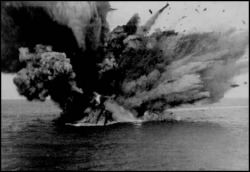
HMS Barham.
A: Picture a convoy moving A to B. The players log on til the wolfpack is full. We will provide reliable communication for the purpose of multiplay. At a safe distance from the action. When ready to converge the players will be able to send messages. Players will also have a map showing the position of the other ships. We'd like to keep everything running through the radio room though a real chat mode will be available for non-gameplay related communications.

U 505. Photo by Tim Burton.
CSIM: In our earlier interview you mentioned a variety of mission types, including mining using the TMB "seabed" mine. What is the challenge in these missions and why are they included?
A: Stealth missions, sneaking around. These missions won't appeal to all, but some players love this kind of thing. So, you sneak in to or just outside of a harbor and start placing mines. You may have to also avoid shore batteries (this feature may not make it in).
These missions were also a major role played by the U-boats early in the war. Leaving them out would distort the role of the U-boat early in the campaign and eliminate a very different kind of challenge that a real U-boat commander experienced.
CSIM: One of the tactics employed by the Kriegsmarine was resupply while at sea with special "milk cow" resupply boats. Are these modeled in Silent Hunter II and will we have to rendezvous while on extended missions?
A: You may meet such a ship on the way to another zone. So, the rendezvous won't be a feature in itself or the goal of the mission, but if you receive orders to move to a new zone, you may have to successfully resupply and refuel on the way.
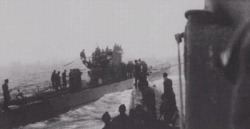
The Milk Cows were U-boats of type XIV and their role was to support the operating VII and IX fighting U-boats by delivering supplies and ammunition. These boats were successful while operating off of the US coast where their location 1000km out of New York permitted the smaller VIIC Atlantic boats to operate in US waters.
They were similarly successful in the Caribbean in 1942, but vastly improved allied radars and better air coverage of the Atlantic eliminated them during 1943, and 14 other XIVs were cancelled.
A: The rendezvous will be represented in the 3D world by a real milch cow. The player will be forced to move within close range of the sub and must stay on the surface for a sufficient period of time for refueling and resupply. This is part of the danger of the operation.
Rendezvousing with a milch cow will be the only way your U-boat can refuel at sea and extend its mission. If the rendezvous is unsuccessful, it could force a return to port or potentially leave you stranded in the Atlantic!

Photo Courtesy of Lester Palifka.
CSIM: Its hard to imagine a graphics environment beyond that of the first Silent Hunter. What are your goals graphically? And will Silent Hunter II be written for Glide as well as D3d?
A: Silent Hunter achieved its "look" by getting everything we possibly could out of the technology available. For example, through careful selection and reuse of colors we were able to squeeze every last ounce out of the 256 color palette, creating a vibrant and dynamic look that belied the actual capabilities of the hardware. With the new 3D cards available, a lot of these limitations have been removed allowing for far more realistic visuals than we could even imagine when developing Silent Hunter over 3 years ago.
Even though Silent Hunter was internally a "3-D" game, its visual representation of ships and aircraft using sprites locked us into viewing from one "plane". This was realistic in that real sub crews were limited to this perspective as well, but it wasn't as satisfying to players who wanted to see the action from a variety of angles.
Silent Hunter II will be fully 3-D, giving the player many more views from which to enjoy the action. Glide support will not be included. Support will be using DirectX 6 and Direct3D.
CSIM: I remember the first time I went up to the bridge on a moon-lit night in the South Pacific. WOW! I remember thinking later that if a seal had crawled to the side of the boat I wouldn't have been surprised! Will there be this much attention to the environment in SH II?
A: There will be the same level of attention to detail. We'll be upgrading most of the effects from Silent Hunter while adding quite a few new ones. Silent Hunter II will use 16-bit color, allowing far better color effects.
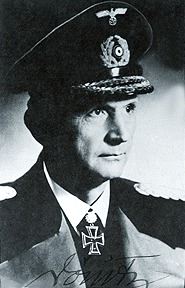
Admiral Doenitz.
We plan on completely revamping the visibility and hazing routines to allow for realistic low visibility weather conditions. In Silent Hunter, under low visibility conditions, ships would simply "pop" into view. The larger palette and better hardware available now makes it possible for us to create a smooth and realistic transition from non-visible to fully visible. Ships will slowly appear out of the haze. This is but one example of the improvements we plan on making to the original graphics engine.
CSIM: What will be the maximum resolution of the graphics engine?
A: The game will support two resolutions, hi-res(800x600) and low-res(640x480).
CSIM: Tell us about object modeling, external as well as internal. We saw some great interiors in Silent Hunter, but they had a static, artwork feel to them.
A: The ships are beautiful. The Aeon crew has done a great job giving the ships a realistic, weathered look. (The Aeon crew has one of the artist's from WW2 Fighters).
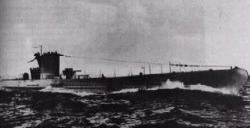
Ultimation (DC) and Aeon (SHII) are showing each other their progress and working well together.
One thing we will have is cheat views, so there is an underwater view available. It's really cool, and even the murkiness of the water varies. If you are making an approach underwater you will have access to an outside view of your sub, even while launching torpedos.
CSIM: Wow. Like a custom on-the-fly cut scene…
A: No one has done this before, and it is REALLY cool.
CSIM: Silent Hunter allowed us to actually sail into port, and view the buildings on shore as well as take shots at ships at anchor. How will this environment change graphically as well as tactically for SH2?
A: These missions will be difficult, but you will see more interactivity and detail in these missions. We are going to take the things we learned from the first sim and take it to a new level. It will be familiar, yet better with more functionality.
CSIM: Will SH2 model weather, and if so how will this impact tactics, resupply etc.?
A: Yes. Water effects have to be in place because of the sea. Weather effects will be in place. You may see storms, but these things are still in discussion.

Courtesy of Tim Burton.
CSIM: In 1944 the Germans built ninety Type 21 Electric Boats, by far the most significant advance in naval platforms during the war. Have you wondered why the Type 21 was never deployed? What have you discovered?
A:The reasons for the Type XXI's slow introduction as well as its possible impact are a ripe subject for a large, controversial book! I'm not sure I'm qualified to write it! Only four Type XXI's were ready by January 1945 and a few actually began to sail from Kiel to Norway toward April. U2511 commanded by Adalbert Schnee made a practice approach on a British cruiser in May, withheld fire, and returned home.
For me, this type of boat is intriguing not just because of its own capabilities and possible impact on the war, but also by imagining what kind of response the Allies would have made to it both technologically and tactically.
The Type XXI had a hydraulic torpedo reload system that enabled the commander to reload all 6 tubes in something like 10 minutes which was even less than it took to reload one tube on the Type VIIC.
Three times the electrical power of the VIIC gave the Type XXI enormous underwater range compared to the older types. It took the boat 3-5 hours to re-charge the batteries with the Schnorchel once every 2-3 days if travelling at moderate 4-8 knots, and thus there was much less danger from aircraft, which sank about 56% of all U-boats lost in the war.
The maximum submerged speed was 17 knots and could be maintained for 60-80 minutes. At the silent submerged cruising speed (5 knots) the Type XXI had to schnorkel for only 3 hours a day to keep the batteries charged. The radar-search receiver Tunis fitted to schnorkel and anti-radar rubber coating offered additional safety. Even when located, an alteration of speed and course would help to evade escorts or aircraft-dropped sonar buoys.
When escaping at high speed, the Type XXI was almost as fast as the Allied escorts, and bubbling of water rushing along the hull would make ASDIC location difficult. The potential area where a hunted Type XXI, escaping at the silent speed of 5 knots, would be forced to raise the schnorkel again was some 10-13 times greater (365 miles) than the area for a conventional U-boat (escaping at 2 knots with a range of 100 miles). Source: U-boat Net.
CSIM: Will Silent Hunter II allow us to play with history and take to the seas in the Type 21?
A: Type XXI's will be included in Silent Hunter II. If the campaign is played with high realism settings, odds are you will receive a Type XXI very late in the war and only for trials (as really occurred). On less realistic levels, they may appear earlier and see combat in the campaign.
CSIM: What other exotic or experimental weapon systems might we see in Silent Hunter II?
A: Possibilities include the Leigh Light, Type XXIII U-boat, and the Focke Achgelis autogyro.
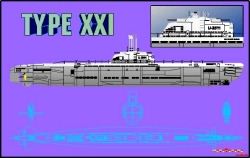
Image courtesy of U-boat Net
CSIM: One of the most exciting aspects of Silent Hunter II is its placement in the Digital Combat Series and a later release titled Destroyer Command. Your goal is to build a destroyer simulation so that players can choose either side of the conflict in the Pacific. Tell us about Destroyer Command.
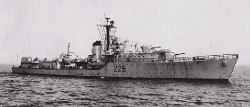
HMCS Sioux.
A: We actually conceived of these games separately. And we don't know if these two will connect in the final release. Escort, hunter killer, landing support, rescue operations… destroyers did it all. With regard to multiplayer interoperability, there is a 50/50 chance that we get it done for these games. But if it doesn't happen on initial release, the long term chances are still good.
CSIM: How many objects are modeled in SH2?
A: Many, but actual numbers are not final. You'll also see a few aircraft, and shore based objects.
CSIM: What stations will be under the player control in Destroyer Command? If a player wants to actually fire a gun at a U Boat on the surface, will he be able to actually get the sub in his sights?
A: You start as a commander, but you can rise to command a Division and then an entire Squadron. You can man every important station when you command an individual ship: radar, guns etc. Or you can sit in the CIC .. and give all commands to the different stations.
At the single ship level most guys will want to jump around. Even the interior of the gun batteries will be fully modeled.
We visited the best restored Fletcher Class (SS Kid) in Louisiana and took hundreds of pictures. We also have talked to commanders and others and picked their brains. It will be an amazing game. There is lots to do on a destroyer.

Courtesy of Tim Burton.
CSIM: Tell us about the multiplayer aspects in DC.
A: It could be that coop play will allow heads of different areas on the same ship, so that one player would give commands and another couple man batteries, for example. We will definitely have the standard multiplayer features with individual control of ships.
CSIM: Does DC use the same graphics engine as SH2?
A: No, it uses an improved 2nd gen Panzer Commander engine with many new features.
CSIM: The Allies had the use of airpower against the U Boats. Will the player on the Allied side have any control over air power in Destroyer Command?
A: Air power is reflected in both sims. The Germans ended up mounting various AA guns on their subs. Deck guns are available to the player in SH2. We're talking about giving you access to the AA guns as well.
CSIM: What about the use of communications in this one? Will I receive communications about U boat sightings? Or will I be part of the Allied Intelligence network and receive intercepted intel on U Boat plans?
A: Communications are very important in DC and is covered in the design doc. We'll have a message center and they will likely be color coded so you can quickly refer to critical messages. CSIM: What about use of voice between stations on the ship? How will I find out, for example, that a U-Boat has just been sighted five miles off?
A: Crew voice and communications are fully developed. You want the feeling of interacting with a real crew.

CSIM: Will there be real time voice in place for multiplayer?
A: Possibly.
CSIM: Thanks! It sounds like Silent Hunter II will be greater than its namesake in every way. We'll be following this one with interest. Personally, I can't wait!

